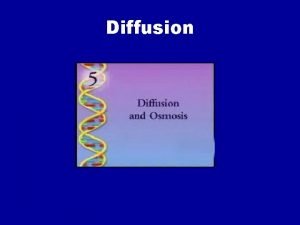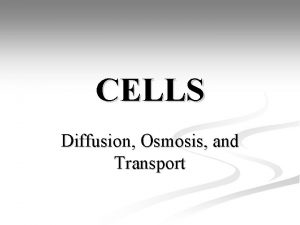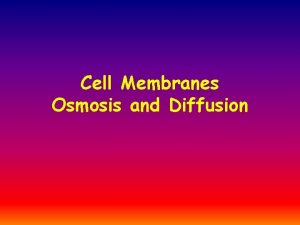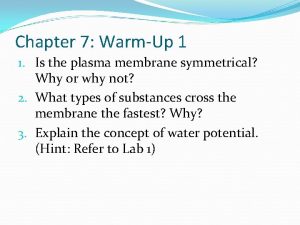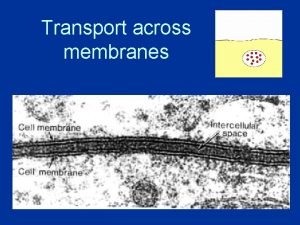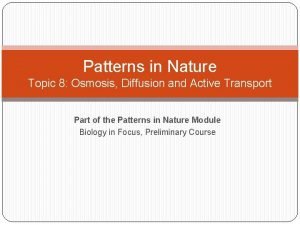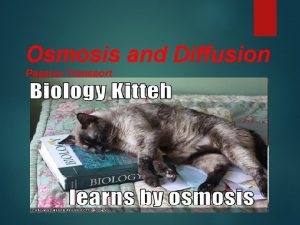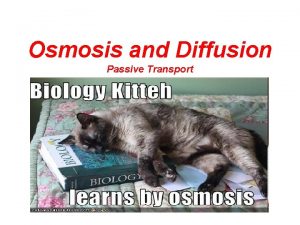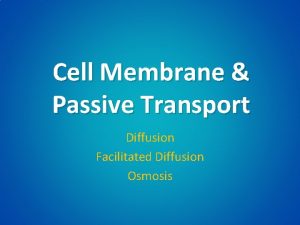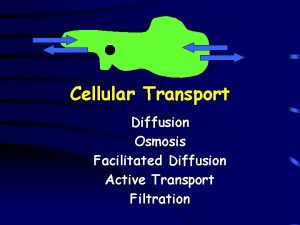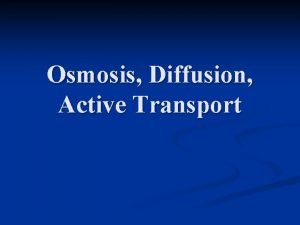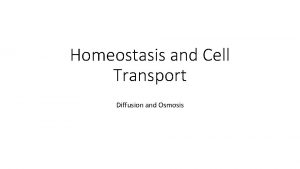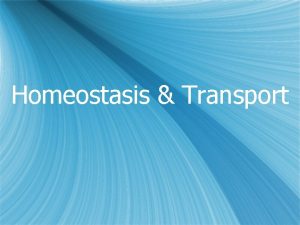PASSIVE TRANSPORT Osmosis Diffusion and Facilitated Diffusion HOMEOSTASIS










- Slides: 10

PASSIVE TRANSPORT Osmosis, Diffusion, and Facilitated Diffusion

HOMEOSTASIS v The purpose of the cell membrane is to help the cell maintain homeostasis… v A constant internal condition v It allows the cell to control what enters and what leaves

PASSIVE TRANSPORT v Some molecules can easily cross the membrane v Water, oxygen and carbon dioxide

THREE FORMS OF PASSIVE TRANSPORT v 1. Diffusion— • Movement of molecules from high to low concentration • The difference in these areas is called the concentration gradient • Does not require energy • Rate depends on temperature, size and type of molecule • Faster at high temps, smaller, and short distance • Continues until even on both sides

THREE FORMS OF PASSIVE TRANSPORT v 2. Osmosis— • Movement of water • High to low concentration (less to more water) • Does not require energy • Will occur until equal

3 TYPES OF OSMOTIC SOLUTIONS v Hypertonic Solution • Solute higher outside the cell • Water will diffuse out of the cell until equilibrium • Cells will shrink and die

3 TYPES OF OSMOTIC SOLUTIONS v Hypotonic • • Solute concentration is higher inside (less water) Water moves into the cell until equal Animal cells will swell and burst Plants work best in this environment

3 TYPES OF OSMOTIC SOLUTIONS v Isotonic • Concentration of solute same inside and outside • Water moves in and out freely • Animal cells work best

3 FORMS OF PASSIVE TRANSPORT v 3. Facilitated Diffusion • Faster than normal diffusion • No energy required • High to low concentration • Uses carrier proteins embedded in the membrane and channel proteins

THE END v
 Plant cells isotonic
Plant cells isotonic Types of diffusion
Types of diffusion Nonmembranous organelles
Nonmembranous organelles Facilitated diffusion and active transport
Facilitated diffusion and active transport Does osmosis require energy
Does osmosis require energy Does facilitated diffusion require a transport protein
Does facilitated diffusion require a transport protein Bioflix activity membrane transport facilitated diffusion
Bioflix activity membrane transport facilitated diffusion Bioflix activity homeostasis low blood glucose
Bioflix activity homeostasis low blood glucose Bioflix activity homeostasis high blood glucose
Bioflix activity homeostasis high blood glucose Facilitated diffusion high to low
Facilitated diffusion high to low Phagocytosis active transport
Phagocytosis active transport
